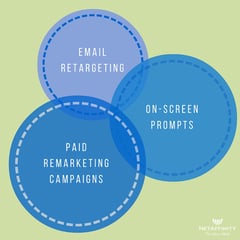After spending substantial budgets and efforts on driving website traffic and encouraging guests to book direct, the last thing any hotelier wants is for someone to abandon at the last hurdle. However, according to SaleCycles Report on Remarketing, cart abandonment rates are highest for the travel industry, at a staggering 81.8%. This is certainly not a figure that any hotelier wants to hear. However, we’re here to help. Follow these guidelines to optimise your re-marketing strategy and combat your abandonment rate.
The Retargeting Trio
1. Paid Remarketing Campaigns: The technique probably used most frequently by Hoteliers is remarketing.
Well-known paid advertising platforms like Google and Facebook offer the ability to re-engage with users, using either cookie lists or email identification. There are also some well-known third party platforms such as Ad Roll which specialise in the area of re-targeting across various platforms. Remarketing adverts give you the chance to keep your hotel in front of the mind and eyes of your indecisive guests.
Here’s an example: Imagine that, as a consumer, you decided to book a hotel and go through the online booking process, but for one of many reasons you didn’t complete this booking—maybe you got distracted by a different site, or decided to wait to book until later.
Sounds familiar?
How about if, over the next 7 days, as you browse the web you’re shown adverts for the hotel you almost booked, or you see an advert for the hotel in your Facebook Newsfeed? You’d be more likely to return and book, wouldn’t you?
Well, this is why re-marketing works. It brings people back into your booking funnel.
In fact, we at Net Affinity are yet to see a hotel where re-marketing doesn’t perform.
However, make sure you’ve got frequency caps on your remarketing ads. This makes sure people aren’t seeing them too often and feeling harassed or followed. Our recommendation would be a maximum of 3 impressions a day, but there’s a little flexibility there depending on your business.
2. Re-Engaging through Email:

Capturing the email address of a user within the booking funnel can be a significant advantage and, when used correctly, email retargeting techniques can return pretty impressive conversion rates. Ideally, the email address of your guest is captured as early in your booking process as possible, so that in the event of an abandonment, you can use this information to re-engage with your abandoned guest with not only their email address, but also the information on the booking they were about to complete, like the date and room type.
Some hotels offer guests an ‘‘exclusive’ offer to encourage them to return and book, for example. Offering a discount code within this communication is also an option. If you weigh up the fact that, without a discount, you might have lost this booking completely or lost the booking to another channel such as booking.com, it’s a win/win. It doesn’t take rocket science to figure out that offering a ‘5% off’ promotional code is more cost effective than paying 18% for a booking through an OTA.
3. On-Screen Prompts.
On-screen prompts can be shown to users based on ‘exit intent’ or ‘page inactivity’. For example, you can present an on-screen message when a user exits the screen. This message can act as a last minute prompt, and encourage users to remain in the booking funnel.
Simply re-enforcing a ‘book direct’ message can keep people with the booking funnel and drive stronger conversion rates.
Conclusion
The challenge for the independent hotelier is clear: to drive as many users through your booking funnel as possible, without losing them to one of those other touch points or websites. Here’s the fix: for those who abandon, use re-targeting to give yourself a second chance and bring them back.




